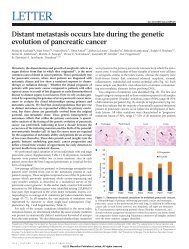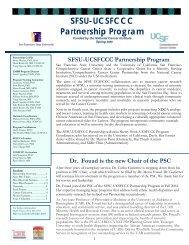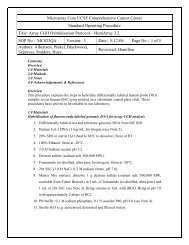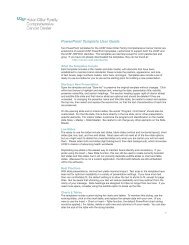Measurement of DNA Copy Number at ... - Cancer Research
Measurement of DNA Copy Number at ... - Cancer Research
Measurement of DNA Copy Number at ... - Cancer Research
You also want an ePaper? Increase the reach of your titles
YUMPU automatically turns print PDFs into web optimized ePapers that Google loves.
[CANCER RESEARCH 60, 5405–5409, October 1, 2000]<br />
Advances in Brief<br />
<strong>Measurement</strong> <strong>of</strong> <strong>DNA</strong> <strong>Copy</strong> <strong>Number</strong> <strong>at</strong> Micros<strong>at</strong>ellite Loci Using Quantit<strong>at</strong>ive<br />
PCR Analysis<br />
David G. Ginzinger, Tony E. Godfrey, Janice Nigro, Dan H. Moore II, Seiji Suzuki, Maria G. Pallavicini,<br />
Joe W. Gray, and Ronald H. Jensen 1<br />
Department <strong>of</strong> Labor<strong>at</strong>ory Medicine, University <strong>of</strong> California San Francisco Comprehensive <strong>Cancer</strong> Center, University <strong>of</strong> California, San Francisco, California 94143<br />
Abstract<br />
This report describes the development and valid<strong>at</strong>ion <strong>of</strong> quantit<strong>at</strong>ive<br />
micros<strong>at</strong>ellite analysis (QuMA) for rapid measurement <strong>of</strong> rel<strong>at</strong>ive <strong>DNA</strong><br />
sequence copy number. In QuMA, the copy number <strong>of</strong> a test locus rel<strong>at</strong>ive<br />
to a pooled reference is assessed using quantit<strong>at</strong>ive, real-time PCR amplific<strong>at</strong>ion<br />
<strong>of</strong> loci carrying simple sequence repe<strong>at</strong>s. Use <strong>of</strong> simple sequence<br />
repe<strong>at</strong>s is advantageous because <strong>of</strong> the large numbers th<strong>at</strong> are mapped<br />
precisely. In addition, all markers are inform<strong>at</strong>ive because QuMA does<br />
not require th<strong>at</strong> they be polymorphic. The utility <strong>of</strong> QuMA is demonstr<strong>at</strong>ed<br />
in assessment <strong>of</strong> the extent <strong>of</strong> deletions <strong>of</strong> chromosome 2 in<br />
leukemias arising in radi<strong>at</strong>ion-sensitive inbred SJL mice and in analysis <strong>of</strong><br />
the associ<strong>at</strong>ion <strong>of</strong> increased copy number <strong>of</strong> the put<strong>at</strong>ive oncogene<br />
ZNF217 with reduced survival dur<strong>at</strong>ion in ovarian cancer p<strong>at</strong>ients.<br />
Introduction<br />
Analysis <strong>of</strong> allelic imbalance <strong>at</strong> specific genomic loci is an important<br />
step in the molecular genetic analysis <strong>of</strong> human cancers because<br />
recurrent regions <strong>of</strong> imbalance signal the loc<strong>at</strong>ions <strong>of</strong> genes th<strong>at</strong> are<br />
involved in disease progression. Often, analysis <strong>of</strong> allelic imbalance is<br />
accomplished by analysis <strong>of</strong> polymorphic micros<strong>at</strong>ellite markers [e.g.,<br />
carrying SSRs 2 (1)]. This approach is powerful because SSRs are<br />
dispersed throughout the genomes <strong>of</strong> most eukaryotes with an average<br />
spacing <strong>of</strong> 30 kb (2–4). However, assays <strong>of</strong> allelic imbalance<br />
typically require allelic heterozygosity so th<strong>at</strong> only a subset <strong>of</strong> the loci<br />
will be inform<strong>at</strong>ive in any individual (5). This is particularly limiting<br />
in experimental murine systems using inbred mouse strains th<strong>at</strong> have<br />
lost heterozygosity. Analyses <strong>of</strong> these mice require cross-breeding to<br />
reintroduce heterozygosity. This is both time-consuming and experimentally<br />
undesirable because the cross-breeding may introduce <strong>DNA</strong><br />
sequence vari<strong>at</strong>ions th<strong>at</strong> alter tumor phenotype.<br />
Here we describe a technique called QuMA th<strong>at</strong> overcomes some <strong>of</strong><br />
these limit<strong>at</strong>ions by allowing analysis <strong>of</strong> the rel<strong>at</strong>ive <strong>DNA</strong> copy<br />
number <strong>at</strong> micros<strong>at</strong>ellite markers distributed throughout the genomes<br />
<strong>of</strong> higher eukaryotes. This real-time, quantit<strong>at</strong>ive PCR technique is an<br />
altern<strong>at</strong>ive to analysis <strong>of</strong> allelic imbalance because most (but not all)<br />
allelic imbalance also results in a change in rel<strong>at</strong>ive copy number. We<br />
demonstr<strong>at</strong>e th<strong>at</strong> QuMA is sufficiently sensitive to detect gain or loss<br />
<strong>of</strong> a single copy <strong>of</strong> a test locus in mouse and human. We show the<br />
biological utility <strong>of</strong> QuMA in localiz<strong>at</strong>ion <strong>of</strong> a put<strong>at</strong>ive tumor suppressor<br />
gene associ<strong>at</strong>ed with radi<strong>at</strong>ion-induced murine myeloid leukemia<br />
on chromosome 2 and in establishing an associ<strong>at</strong>ion between<br />
Received 5/5/00; accepted 8/16/00.<br />
The costs <strong>of</strong> public<strong>at</strong>ion <strong>of</strong> this article were defrayed in part by the payment <strong>of</strong> page<br />
charges. This article must therefore be hereby marked advertisement in accordance with<br />
18 U.S.C. Section 1734 solely to indic<strong>at</strong>e this fact.<br />
1 To whom requests for reprints should be addressed, <strong>at</strong> University <strong>of</strong> California San<br />
Francisco Comprehensive <strong>Cancer</strong> Center, <strong>Cancer</strong> Genetics and Breast Oncology Program,<br />
2340 Sutter Street, Room S431, San Francisco, CA 94143.<br />
2 The abbrevi<strong>at</strong>ions used are: SSR, simple sequence repe<strong>at</strong>s; QuMA, quantit<strong>at</strong>ive<br />
micros<strong>at</strong>ellite analysis; FAM, 6-carboxy fluorescein; TI, tolerance interval; CGH, compar<strong>at</strong>ive<br />
genomic hybridiz<strong>at</strong>ion; FISH, fluorescence in situ hybridiz<strong>at</strong>ion; BAC, bacterial<br />
artificial chromosome; Ct, threshold cycle; MDA 361, MDA-MB-361.<br />
5405<br />
increased copy number <strong>of</strong> the put<strong>at</strong>ive oncogene ZNF217 and reduced<br />
survival dur<strong>at</strong>ion in human ovarian cancer.<br />
M<strong>at</strong>erials and Methods<br />
QuMA<br />
During QuMA, test and reference loci containing (CA)n repe<strong>at</strong>s were<br />
amplified using PCR in the presence <strong>of</strong> TaqMan probe homologous for a<br />
(CA)n repe<strong>at</strong>. The amount <strong>of</strong> FAM fluorescence in each reaction liber<strong>at</strong>ed by<br />
the exonuclease degrad<strong>at</strong>ion <strong>of</strong> the TaqMan probe during PCR amplific<strong>at</strong>ion<br />
was measured as a function <strong>of</strong> PCR cycle number using an ABI 7700 Prism<br />
(PE Biosystems, Foster City CA; Refs. 6–9). The number <strong>of</strong> PCR cycles (Ct)<br />
required for the FAM intensities to exceed a threshold just above background<br />
was calcul<strong>at</strong>ed for the test and reference reactions. Ct values were determined<br />
for three test and three reference reactions in each sample, averaged, and<br />
subtracted to obtain Ct [Ct Ct (test locus) Ct (pooled reference)]. Ct<br />
values were measured for each unknown sample [Ct (test <strong>DNA</strong>)] and for<br />
samples from several unrel<strong>at</strong>ed, normal (calibr<strong>at</strong>or) individuals [average<br />
Ct (calibr<strong>at</strong>or <strong>DNA</strong>)]. Rel<strong>at</strong>ive copy number <strong>at</strong> each locus in the test<br />
sample was then calcul<strong>at</strong>ed as:<br />
Rel<strong>at</strong>ive <strong>DNA</strong> copy number 1 E Ct (1)<br />
where Ct Ct (test <strong>DNA</strong>) Ct (calibr<strong>at</strong>or <strong>DNA</strong>), and E PCR<br />
efficiency. For simplicity, we used primers with PCR efficiencies <strong>of</strong> 85%<br />
and calcul<strong>at</strong>ed the rel<strong>at</strong>ive <strong>DNA</strong> copy number as 2 Ct ( 2 when known to<br />
be a diploid test sample, such as normal male <strong>DNA</strong>, or mouse knockout <strong>DNA</strong><br />
or with FISH analysis <strong>of</strong> mouse tumors).<br />
To determine whether a QuMA measurement on a single sample was significantly<br />
different from the mean <strong>of</strong> measurements made on samples from a number<br />
<strong>of</strong> normal individuals, a TI was calcul<strong>at</strong>ed using the mean and SD <strong>of</strong> Ct values<br />
from each marker and the pooled reference according to the following formula:<br />
TI 2 {SD (all markers) 2.28}) ( 2 for mouse leukemia <strong>DNA</strong>s) (2)<br />
where 2.28 was a two-sided tolerance limit factor assuming a normal distribution<br />
for a total <strong>of</strong> n 140 mouse loci (10). The measured rel<strong>at</strong>ive copy<br />
number <strong>of</strong> a normal sample will be within 2 TI 95% <strong>of</strong> the time with 95%<br />
confidence. Thus, individual measurements outside this range were considered<br />
significantly different from normal.<br />
PCR<br />
PCR was conducted in triplic<strong>at</strong>e with 50-l reaction volumes <strong>of</strong> 1 PCR<br />
buffer A (PE Biosystems), 2.5 mM MgCl 2, 0.4 M each primer, 200 M each<br />
deoxynucleotide triphosph<strong>at</strong>e, 100 nM probe, and 0.025 unit/l Taq Gold (PE<br />
Biosystems) with 1–5 ng <strong>of</strong> genomic <strong>DNA</strong>. A large master mix <strong>of</strong> the<br />
above-mentioned components was made for each experiment and aliquoted<br />
into each optical reaction tube. Each primer set (5–10 l volume) was then<br />
added, and PCR was conducted using the following cycle parameters: 1 cycle<br />
<strong>of</strong> 95°C for 12 min and 40 cycles <strong>of</strong> 95°C for 20 s, 55°C for 20 s, 72°C for 45 s.<br />
Analysis was carried out using the sequence detection s<strong>of</strong>tware supplied with<br />
the ABI 7700 (PE Biosystems). The Ct values for each set <strong>of</strong> three reactions<br />
were averaged for all subsequent calcul<strong>at</strong>ions. Pooled variance for all sets <strong>of</strong><br />
PCR triplic<strong>at</strong>es was 0.018 (n 288), indic<strong>at</strong>ing sufficient st<strong>at</strong>istical power<br />
with this level <strong>of</strong> intra-assay vari<strong>at</strong>ion to detect a difference <strong>of</strong> 0.25 cycle<br />
between samples with gre<strong>at</strong>er than 95% confidence.
Oligonucleotides<br />
PCR primer sequences for micros<strong>at</strong>ellite loci were obtained from either the<br />
Whitehead Institute Massachusetts Institute <strong>of</strong> Technology Center for Genome<br />
<strong>Research</strong> 3 or Washington University (St. Louis, MO). 4 Primers were synthesized<br />
by Life Technologies, Inc. (Gaithersburg, MD) or Integr<strong>at</strong>ed <strong>DNA</strong> Technologies<br />
(Coralville, IA). The reference pools contained primer pairs for six or seven<br />
different loci. For human analyses, loci were chosen in regions <strong>of</strong> the genome th<strong>at</strong><br />
3 World Wide Web address: www.genome.wi.mit.edu.<br />
4 World Wide Web address: www.genlink.wustl.edu.<br />
QUANTITATIVE MICROSATELLITE ANALYSIS<br />
Table 1 Primers used in QuMA studies<br />
Forward primer Reverse primer<br />
Human primers for<br />
D8S258 CTGCCAGGAATCAACTGAG TTGACAGGGACCCACG<br />
D15S126 GTGAGCCAAGATGGCACTAC GCCAGCAATAATGGGAAGTT<br />
D17S849 CAATTCTGTTCTAAGATTATTTTGG CTCTGGCTGAGGAGGC<br />
DXS453 CACACTGCATTAAATCCTCG CAAGTTACCCTACCTGCCTC<br />
DXS1052 GCCATGTGTCAAGGCTGATT TAACCTCTCTCGCTCGCTCT<br />
DXS1196 CTAAATTCTCCTCCACCGTG TTTCCAGAGCAGATTTTCAGT<br />
D20S120 TTTTACTAAGGAGACTCAACAGGG TTGCACAATGCCTGGAA<br />
D20S183 GCACATAAAACAGCCAGC CCGGGATACCGACATTG<br />
D20S211 TTGGAATCAATGGAGCAAAA AGCTTTACCCAATGTGGTCC<br />
D20S876 ATCATTTAGGGATTAAGTTCCTAC ATCACGCCACTGCACT<br />
D20S894 GAAGCACCCTGTGGAGTTA CAATCCTGCAAAAAAGTCA<br />
D20S902 GGACGTTCACACTTTATGCC GAGGATGCTTGCCATTTTC<br />
D20S913<br />
Mouse primers for<br />
CTGCTCTAAGGTCAGAGTGATG CGATATGTAGGTTTACAAGGTTCC<br />
D2MIT62 GGATACCGTTTGGAAAGTAAACC GCAAGAAGCACAGGAGGC<br />
D2MIT63 GCAGTCTACCAGGAGCAACC TGGATGTAGGCATGTGCCT<br />
D2MIT65 CTGAAAAAGGAAACAAGGTTGG CCCACTCTTTAGACAGAGGGG<br />
D2MIT57 CCTCACAACTATGTCAGGTAATGG GGATGAGGGATTAAAAATAGATGC<br />
D2MIT58 ATAGTTGGTTTTTGTTGCTATTGC TGCATTTGCAACATACCCC<br />
D2MIT15 ATGCCTTAGAAGAATTTGTTCCC CTTGAAAAACACATCAAAATCTGC<br />
D2MIT100 GTGTTCCTAAGGTTGTATTTTGGC GAAATTTGACAATTGCTAGGTGC<br />
D2MIT107 GGGAGTGAAGCCAGCATAAG AACTGACTGAGTTTCAAAGTGCC<br />
D2MIT112 ACTGTGTGCTTTTGTTTTGGG CAACACTATGGAGGCAGGGT<br />
D2MIT142 AGCAAGGCATAAGGAGACCA GGGTGGCTCTATTAGGCACA<br />
D2MIT175 ATGACAAACAAGAAATAGGAAGGC CATGTGCTTGAGCATGCAC<br />
D2MIT224 GGAACTACTAACTAGGTGAATTCACTG CTTGAGAATGTTATGCTAGGAAGG<br />
D2MIT244 AGGGCTCTGCTCATGCAC ACCACCTGTATCATGGACTTCA<br />
D2MIT262 ACTCTCATGTGTGCCATTATGC TGTTAGCCTCTCTGCTTCTGC<br />
D2MIT304 AAGCAGGTGTCGCTGATTG AGAAGATGGACCGAGGGG<br />
D2MIT337 GATGCAATTCCTTCCAGCAT GAACCACTGTGTGATCGTCTATG<br />
D2MIT339 TTGCACCAGGTTCTCAGAGA TAAGTGTTGCAGCATTTGTGC<br />
D2MIT356 TGCAGTGCCAGATGTGTGT TCGACTCCTGTCTCTCTCAGG<br />
D2MIT373 AGTGATTGAGGAAGACGTTTTACC GAACTTGCTCTGCCCAGTTC<br />
D2MIT395 AGGTCAGCCTGGACTATATGG AGCATCCATGGGATAATGGT<br />
D2MIT415 AGACCCGAGTCCCAAAAGTT CTGGCTCTCTGAGTCCGTTC<br />
D2MIT419 ACCAGGAACCTGAGACTAAATATCC GGGGATAAATAAAAATAAACAAGAATC<br />
D2MIT423 TAGAATGTTTGTCTGTTGATGAATATG CAGAGAATGGGCAAGTACAGC<br />
D2MIT436 ATCCACGAGTGTCTTTTCCC TGTTAAGTTTTGGAGAAGAGTAAAAGG<br />
D2MIT447 CATGTGCCATGGTACAAAGC TGGCTTGTTTCAGATAGCACA<br />
D2MIT493 GTCTCTACCTGAGTTTCCATCACA TCCCGAGTTGTCCCTCTATG<br />
D2MIT9 GTCTGCACTCTCACCAGCAA CAGCTTGAAATGCCTTTGAG<br />
D3MIT12 TAGACCAATCTTGGGAGTGTCC GGAAAAGCATAAGAAACAACCG<br />
D7MIT7 ACTCAAAGGTTGTCCTGGCA TGGTAGTGGTGGCTNCGGTG<br />
D11MIT23 AAAGCAGAGAAGTCTCACCCCT GCACACAGTCATGCAGCAC<br />
D12MIT10 ATCGTGGGAACAAGACCATC AGAATTCATGCTTTGCATTGG<br />
D13MIT184<br />
Human reference pool primers for<br />
ACGCTAGGAAGTGGCTCAAA ACATGTGTCAGTCTTCGTTCTCA<br />
D1S2868 AGGTATAATCTGCAATAAAAAACTT AAAGTAAAACAATATGAAGCCAC<br />
D2S385 AGCTGTCAGTAGAAATAAGCAGAGA TCAATAACACGCCAAAAGAC<br />
D4S1605 CATTCTAGTAGTTATTGGCTTATCC CAGTTGCTTGATACCTATATTTTTC<br />
D5S478 CCGTTTGCACATTTGAGGCT CTGAAAAAGAAGGCAACGTC<br />
D5S643 TGGGCGACAGAGCCATC TGTGGTGTGCCATTTATTGACT<br />
D10S586 TATTATACTCCAGCCGGGG GGAGACTATTTACTTTGTGTCCTTG<br />
D11S1315 AAAGGCACAAAAACTAAAACTCTGG CCGTCAGTGTGATAAAAGCCAG<br />
D11S913 CTAGATTTCTGAAACTCAAATGCA TAGGTGTCTTATTTTTTGTTGCTTC<br />
D12S1699 ATCACCTCATGCCTGTTAGG GTGTTTCGTTCACATCCTGG<br />
D14S988 TGGTGATTGGATATCACTGGT ATGTTATGTAAGGTTTTGTTTTGTT<br />
D21S1904 ATGAGTTCAGTGTTTCATGGACATC AGCAAGATTACTGTCTGGTTTCCC<br />
D22S922<br />
Mouse reference pool primers for<br />
GTATCTTGATGGTGGTGTTGG TTTCCTCAGTTTTACCTGTGCT<br />
D1MIT64 AGTGCATTATGAAGCCCCAC TCAAATTTTAAAACAACCCATTTG<br />
D2MIT175 ATGACAAACAAGAAATAGGAAGGC CATGTGCTTGAGCATGCAC<br />
D3MIT12 TAGACCAATCTTGGGAGTGTCC GGAAAAGCATAAGAAACAACCG<br />
D12MIT10 ATCGTGGGAACAAGACCATC AGAATTCATGCTTTGCATTGG<br />
D13MIT250 ACACTCATTTCCATGCACGA AGGTCCTCAAATCTCACAAGTAGG<br />
D14MIT5 CACATGAACAGAGGGGCAG GTCATGAAGTGCCCACCTTT<br />
5406<br />
usually did not show alter<strong>at</strong>ions in human breast tumors (human pool 1, D4S1605,<br />
D5S478, D11S913, D12S1699, D14S988, D21S1904, and D22S922) or ovarian<br />
tumors (human pool 2, D1S2868, D2S385, D4S1605, D5S643, D10S586, and<br />
D11S1315) when analyzed by CGH (11). The murine reference loci were<br />
D1MIT64, D2MIT175, D3MIT12, D12MIT10, D13MIT250, and D14MIT5.<br />
Primer sequences for the test and reference loci analyzed in this study are listed in<br />
Table 1. The TaqMan CA-repe<strong>at</strong> fluorogenic probe consisted <strong>of</strong> the following<br />
sequence: 5-FAM-TGTGTGTGTGTGTGTGTGTGT-6-carboxy tetramethyl<br />
rhodamine-3. ZNF217 primers and probe were as reported previously (12). Both<br />
probes were purchased from PE Biosystems.
Fig. 1. QuMA and FISH analyses <strong>of</strong> human<br />
chromosome 20q copy number in breast cancer cell<br />
lines using precisely mapped BACs and SSRs (12),<br />
plus BAC clone B4104 and P1 clone P4120. 5 a,<br />
QuMA measurements <strong>of</strong> rel<strong>at</strong>ive copy number for<br />
breast cancer cell lines are shown as symbols connected<br />
by lines. MCF-7 values are shown as <br />
connected by solid lines. SKBR3 values are shown<br />
as f connected by dashed lines. FISH measurements<br />
<strong>of</strong> rel<strong>at</strong>ive copy number are shown as horizontal<br />
lines whose lengths indic<strong>at</strong>e the physical<br />
extent <strong>of</strong> the BAC used as probes. MCF-7 values<br />
are shown as solid lines. SKBR3 values are shown<br />
as gray lines. These cell lines show a moder<strong>at</strong>e to<br />
high level <strong>of</strong> amplific<strong>at</strong>ion. b, QuMA measurements<br />
<strong>of</strong> rel<strong>at</strong>ive copy number for breast cancer<br />
cell lines are shown as symbols connected by lines.<br />
HS578T values are shown as f connected by long<br />
dashed lines. HBL100 values are shown as <br />
connected by short dashed lines. MDA361 values<br />
are shown as Πconnected by solid lines. FISH<br />
measurements <strong>of</strong> rel<strong>at</strong>ive copy number are shown<br />
as horizontal lines whose lengths indic<strong>at</strong>e the physical<br />
extent <strong>of</strong> the BACs used as probes. MDA361<br />
values are shown as solid lines. HBL100 values are<br />
shown as gray lines. HS578T values are shown as<br />
vertically h<strong>at</strong>ched horizontal lines. These cell lines<br />
show normal to low-level copy number increase.<br />
FISH<br />
Murine spleen cells on microscope slides fixed using methanol-acetic acid<br />
were analyzed using dual-color FISH with BAC probes as described previously<br />
(13). Hybridiz<strong>at</strong>ion domains <strong>of</strong> each color were enumer<strong>at</strong>ed in <strong>at</strong> least<br />
100 metaphase or interphase nuclei for each analysis. BAC clones containing<br />
SSRs D2MIT356 (BAC356), D2MIT62 (BAC62), and D2MIT415 (BAC415)<br />
were selected from a BAC library as described previously (14). <strong>DNA</strong> from<br />
each BAC clone was extracted and purified using a midi-prep column according<br />
to manufacturer’s recommend<strong>at</strong>ions (Qiagen, Santa Clarita, CA) and<br />
labeled by nick transl<strong>at</strong>ion to incorpor<strong>at</strong>e dCTP FITC or Texas Red (13).<br />
Specimens<br />
Murine. Two inbred strains <strong>of</strong> mice were evalu<strong>at</strong>ed: (a) a FVB knockout<br />
mouse (design<strong>at</strong>ed M11) th<strong>at</strong> lacked a 700-kb segment <strong>of</strong> chromosome 11<br />
(kindly provided by Dr. E. Rubin; Lawrence Berkeley N<strong>at</strong>ional Labor<strong>at</strong>ory,<br />
Berkeley, CA); tail <strong>DNA</strong> samples were obtained from M11 / , M11 / , and<br />
M11 / FVB mice; and (b) 3-month-old SJL mice (Jackson Labor<strong>at</strong>ories, Bar<br />
Harbor, ME) exposed to 3 Gy <strong>of</strong> ionizing radi<strong>at</strong>ion from a Cs 137 irradi<strong>at</strong>or.<br />
Spleen and marrow samples were collected for <strong>DNA</strong> isol<strong>at</strong>ion after 7–9<br />
months.<br />
Human. All specimens were collected and used with the approval <strong>of</strong> the<br />
Committee on Human <strong>Research</strong> <strong>at</strong> the University <strong>of</strong> California, San Francisco.<br />
These specimens included: (a) blood samples collected from normal, healthy,<br />
male and female donors for analysis <strong>of</strong> X chromosome copy number; (b)<br />
ovarian tumor samples collected as described by Suzuki et al. (15); and (c)<br />
human breast cancer cell lines HBL100, MDA-MB-361, HS578T, SKBR3,<br />
and MCF-7 obtained from American Type Culture Collection (Manassas, VA)<br />
and cultured as recommended by the supplier.<br />
5 Collins, C., unpublished observ<strong>at</strong>ions.<br />
QUANTITATIVE MICROSATELLITE ANALYSIS<br />
5407<br />
<strong>DNA</strong> Isol<strong>at</strong>ion<br />
<strong>DNA</strong> was extracted from either tail clippings or spleens <strong>of</strong> mice and<br />
processed with a Puregene <strong>DNA</strong> extraction kit (Gentra Systems, Minneapolis,<br />
MN) used according to the manufacturer’s purific<strong>at</strong>ion recommend<strong>at</strong>ions.<br />
<strong>DNA</strong> was extracted from human blood specimens and cell lines using a Wizard<br />
Genomic <strong>DNA</strong> purific<strong>at</strong>ion kit from Promega (Madison, WI). Ovarian tumor<br />
<strong>DNA</strong> was isol<strong>at</strong>ed as described previously (15).<br />
CGH<br />
CGH was performed on <strong>DNA</strong> from three SJL mice as described by Kallioniemi<br />
et al. (16). Mouse metaphase chromosome spreads were prepared<br />
from phytohemagglutinin-stimul<strong>at</strong>ed murine peripheral blood lymphocytes <strong>of</strong><br />
a normal C57BL mouse. Image analysis was conducted as described by Piper<br />
et al. (17).<br />
Results and Discussion<br />
Valid<strong>at</strong>ion<br />
Amplific<strong>at</strong>ion. We used QuMA to measure the levels <strong>of</strong> amplific<strong>at</strong>ion<br />
<strong>of</strong> SSR loci mapped to 20q13.2 and the put<strong>at</strong>ive oncogene<br />
ZNF217 in five breast cancer cell lines th<strong>at</strong> had been assessed previously<br />
using FISH (11, 18). Fig. 1 shows good concordance between<br />
the two methods. Cell lines HBL100, MDA-MB-361, and HS578T<br />
show only modest increases (less than five copies) in <strong>DNA</strong> copy<br />
number, whereas SKBR3 and MCF-7 show high-level amplific<strong>at</strong>ions<br />
(up to 40 copies). However, the levels <strong>of</strong> amplific<strong>at</strong>ion measured<br />
using FISH and QuMA differ by as much as 2 <strong>at</strong> some loci. We<br />
specul<strong>at</strong>e th<strong>at</strong> this is because the extent <strong>of</strong> the genome interrog<strong>at</strong>ed<br />
differs between the two methods. QuMA assesses copy number <strong>at</strong> a
specific 200-bp wide locus, whereas FISH measures copy number<br />
using an 100-kb probe. The number <strong>of</strong> hybridiz<strong>at</strong>ion signals gener<strong>at</strong>ed<br />
using FISH will vary in an uncertain manner if the level <strong>of</strong><br />
amplific<strong>at</strong>ion changes across the extent <strong>of</strong> the region covered by the<br />
probe. In addition, copy number is difficult to measure in interphase<br />
nuclei using FISH when the level <strong>of</strong> amplific<strong>at</strong>ion is high. On the<br />
other hand, FISH is less sensitive to the presence <strong>of</strong> admixed normal<br />
cells. The level <strong>of</strong> aneusomy in these cell lines may also contribute to<br />
the difference because the reference loci may be elev<strong>at</strong>ed in copy<br />
number, resulting in underrepresent<strong>at</strong>ion <strong>of</strong> the absolute <strong>DNA</strong> copy<br />
number. Thus, analysis using both methods may be appropri<strong>at</strong>e in<br />
cases <strong>of</strong> high-level amplific<strong>at</strong>ion or aneusomy.<br />
Single <strong>Copy</strong> <strong>Number</strong> Changes. We assessed the ability <strong>of</strong> QuMA<br />
to detect monosomy by comparing copy number measurements on the<br />
X chromosome in human males with copy number <strong>at</strong> three autosomal<br />
loci and by analyzing copy number in a region <strong>of</strong> chromosome 11<br />
deleted in a mouse knockout experiment. QuMA analyses in the<br />
human showed a rel<strong>at</strong>ive copy number <strong>of</strong> 1.08 0.035 for three<br />
autosomal loci (D8S258, D15S126, and D17S849) in male <strong>DNA</strong> and<br />
0.46 0.06 for the three nonpseudoautosomal X chromosome loci<br />
(DXS453, DXS1052, and DXS1196). QuMA measurements <strong>of</strong> rel<strong>at</strong>ive<br />
copy number <strong>at</strong> D11MIT23 in a 700-kb segment <strong>of</strong> chromosome<br />
11 deleted by homologous recombin<strong>at</strong>ion 6 and <strong>at</strong> six autosomal loci<br />
(D1MIT64, D2MIT175, D3MIT12, D12MIT10, D13MIT250, and<br />
D14MIT5) were 0.59 0.06 and 1.03 0.13, respectively. Both studies<br />
clearly show th<strong>at</strong> QuMA is sufficiently sensitive to distinguish one copy<br />
from two copies.<br />
To further define the sensitivity <strong>of</strong> QuMA, we mixed <strong>DNA</strong> from a<br />
chromosome 11 knockout mouse with increasing amounts <strong>of</strong> <strong>DNA</strong><br />
from normal FVB mice. QuMA was performed on these <strong>DNA</strong> mixtures<br />
<strong>at</strong> D11MIT23, D2MIT175, and D13MIT250. Fig. 2A shows th<strong>at</strong><br />
QuMA was able to distinguish the reduced copy number <strong>at</strong><br />
D11MIT23 even in the presence <strong>of</strong> 30% <strong>of</strong> normal <strong>DNA</strong>. Specifically,<br />
QuMA showed a 90% chance <strong>of</strong> detecting a difference between one<br />
copy and two copies, with 95% confidence under these conditions.<br />
Thus, QuMA should be able to detect the loss <strong>of</strong> one allele in tumor<br />
samples contamin<strong>at</strong>ed by this amount <strong>of</strong> normal <strong>DNA</strong>.<br />
Demonstr<strong>at</strong>ion Applic<strong>at</strong>ions<br />
Deletion Analysis in Tumors in Inbred Mice. The SJL mouse<br />
strain has been shown to develop acute leukemias <strong>at</strong> high frequency<br />
when irradi<strong>at</strong>ed. Recurrent allelic imbalance <strong>of</strong> an 30-cM region <strong>of</strong><br />
chromosome 2E has been reported in tumors in F 1 crosses <strong>of</strong> these<br />
mice (19, 20). We used QuMA to assess deletions <strong>at</strong> 27 loci along<br />
chromosome 2 using spleen <strong>DNA</strong> from eight irradi<strong>at</strong>ed SJL mice. Six<br />
<strong>of</strong> the eight spleens were comprised mostly <strong>of</strong> leukemic cells. Fig. 2B<br />
shows th<strong>at</strong> these analyses define an 23-cM-wide region <strong>of</strong> common<br />
deletion between D2MIT9 and D2MIT337. The QuMA results are<br />
consistent with those obtained using FISH and CGH. CGH analysis <strong>of</strong><br />
<strong>DNA</strong> from spleens from two irradi<strong>at</strong>ed mice with leukemia (mice<br />
2.4B and 11.2) and one irradi<strong>at</strong>ed mouse without leukemia (mouse<br />
2.1B) showed chromosome 2 copy number losses in the two leukemic<br />
mice and no loss in the nonleukemic mouse. FISH analyses <strong>of</strong> spleens<br />
from two other irradi<strong>at</strong>ed mice with leukemia (mice 2.5 and 12.2) and<br />
one mouse without leukemia (mouse 8.5) were performed using BAC<br />
clones mapped to chromosome regions 2A(BAC356), 2E(BAC62),<br />
and 2H(BAC415). For the nonleukemic mouse (mouse 8.5), the<br />
2A:2E copy number r<strong>at</strong>io was 0.92, whereas in leukemic mice (mice<br />
2.5 and 12.2), the r<strong>at</strong>ios were 1.67 and 1.89, respectively. The 2A:2H<br />
r<strong>at</strong>ios for the same mice were both 1.02, indic<strong>at</strong>ing th<strong>at</strong> these mice<br />
6 Rubin et al., unpublished observ<strong>at</strong>ions.<br />
QUANTITATIVE MICROSATELLITE ANALYSIS<br />
5408<br />
Fig. 2. A, <strong>DNA</strong> mixing experiment in which normal SJL <strong>DNA</strong> was added with<br />
hemizygous chromosome 11 knockout <strong>DNA</strong> in increments <strong>of</strong> 10%. <strong>DNA</strong> copy number<br />
was measured <strong>at</strong> marker D2MIT23 (, experiment 1; f, experiment 2) and is compared<br />
with markers D2MIT65 (E, experiment 1; F, experiment 2) and D13MIT184 (‚,<br />
experiment 1; Œ, experiment 2). B, leukemic and normal mice were measured for <strong>DNA</strong><br />
copy number using QuMA <strong>at</strong> 27 loci on chromosome 2 and 3 loci on other chromosomes.<br />
Results for six leukemic mice show a common region <strong>of</strong> deletion between markers<br />
D2MIT9 and D2MIT337 (23 cM).<br />
have an interstitial deletion <strong>of</strong> in the region <strong>of</strong> 2E. These results<br />
demonstr<strong>at</strong>e the utility <strong>of</strong> QuMA for high-resolution mapping <strong>of</strong> the<br />
extent <strong>of</strong> physical deletions in inbred mouse strains, obvi<strong>at</strong>ing the<br />
need for expensive and time-consuming backcrossing.<br />
Reproducibility. To assess the reproducibility <strong>of</strong> QuMA, 13 markers<br />
were measured three times on four irradi<strong>at</strong>ed mice. The average
Fig. 3. Kaplan-Meier survival curves for 60 p<strong>at</strong>ients with and without <strong>DNA</strong> copy<br />
number gains <strong>at</strong> ZNF217 in chromosomal band 20q13.2, as detected by QuMA. a,<br />
survival <strong>of</strong> all p<strong>at</strong>ients with ZNF217 gains. b, survival <strong>of</strong> p<strong>at</strong>ients with l<strong>at</strong>e-stage tumors.<br />
rel<strong>at</strong>ive copy number for the disomic loci was 2.00 0.26 (n 123),<br />
with 5 <strong>of</strong> 123 measurements outside the TI (three above the cut<strong>of</strong>f<br />
values and two below the cut<strong>of</strong>f values). The average rel<strong>at</strong>ive copy<br />
for monosomic loci was 0.94 016 (n 30), with all values outside<br />
the TI.<br />
Assessment <strong>of</strong> Prognostic Markers in Human Tumors. Amplific<strong>at</strong>ions<br />
<strong>of</strong> several regions <strong>of</strong> chromosome 20q occur frequently in a<br />
broad range <strong>of</strong> human cancers including ovarian cancer (11). Several<br />
put<strong>at</strong>ive oncogenes have been identified in these regions including the<br />
put<strong>at</strong>ive zinc-finger transcription factor ZNF217 (12). Amplific<strong>at</strong>ion<br />
<strong>of</strong> this gene has been associ<strong>at</strong>ed with reduced survival dur<strong>at</strong>ion in<br />
human breast cancer (21). We used QuMA to test the associ<strong>at</strong>ion<br />
between ZNF217 copy number increase and reduced survival for 60<br />
ovarian cancer p<strong>at</strong>ients. The Kaplan-Meier survival curves for p<strong>at</strong>ients<br />
with or without increased copy number <strong>of</strong> ZNF217 in Fig. 3 show th<strong>at</strong><br />
increased copy number <strong>of</strong> this gene was significantly associ<strong>at</strong>ed with<br />
reduced survival dur<strong>at</strong>ion in l<strong>at</strong>e-stage tumors and all tumors. This<br />
study demonstr<strong>at</strong>es the utility <strong>of</strong> QuMA for rapid detection <strong>of</strong> prognostic<br />
copy number changes in human cancers.<br />
Conclusion<br />
We have demonstr<strong>at</strong>ed the utility <strong>of</strong> QuMA for rapid measurement<br />
<strong>of</strong> rel<strong>at</strong>ive <strong>DNA</strong> copy number in the genomes <strong>of</strong> mouse and human<br />
tumors. QuMA distinguishes between increases and decreases in copy<br />
number and takes advantage <strong>of</strong> the large number <strong>of</strong> SSRs th<strong>at</strong> have<br />
already been mapped and for which PCR primers are conveniently<br />
available. Of course, it does not detect events leading to loss <strong>of</strong><br />
heterozygosity or other abnormalities th<strong>at</strong> do not alter genome copy<br />
number. The use <strong>of</strong> a single TaqMan probe for all test and reference<br />
loci makes the method cost effective. The use <strong>of</strong> a “pooled reference”<br />
reduces the possibility th<strong>at</strong> loss/gain <strong>of</strong> a single reference marker<br />
might lead to erroneous assignment <strong>of</strong> copy number <strong>at</strong> a test locus.<br />
However, the pooled reference should be designed to include loci th<strong>at</strong><br />
are not frequently altered in copy number in the system under study<br />
and may not provide a useful reference for determining absolute copy<br />
number in highly aneusomic tumors. Published CGH and LOH anal-<br />
QUANTITATIVE MICROSATELLITE ANALYSIS<br />
5409<br />
yses may be used to guide the selection <strong>of</strong> reference loci. QuMA is<br />
advantageous because it does not require th<strong>at</strong> the SSRs be polymorphic.<br />
This is particularly helpful in high-resolution analyses <strong>of</strong> the<br />
extent <strong>of</strong> regions <strong>of</strong> genome copy number abnormality in humans and<br />
inbred mouse tumors and for assessment <strong>of</strong> the presence <strong>of</strong> prognostic<br />
copy number abnormalities in individual tumors.<br />
References<br />
1. Cawkwell, L., Bell, S. M., Lewis, F. A., Dixon, M. F., Taylor, G. R., and Quirke, P.<br />
Rapid detection <strong>of</strong> allele loss in colorectal tumours using micros<strong>at</strong>ellites and fluorescent<br />
<strong>DNA</strong> technology. Br. J. <strong>Cancer</strong>, 67: 1262–1267, 1993.<br />
2. Beckman, J. S., and Weber, J. L. Survey <strong>of</strong> human and r<strong>at</strong> micros<strong>at</strong>ellites. Genomics,<br />
12: 627–631, 1992.<br />
3. Bra<strong>at</strong>en, D. C., Thomas, J. R., Little, R. D., Dickson, K. R., Goldberg, I.,<br />
Schlessinger, D., Ciccodicola, A., and D’Urso, M. Loc<strong>at</strong>ions and contexts <strong>of</strong> sequences<br />
th<strong>at</strong> hybridize to poly(dG-dT)(dC-dA) in mammalian ribosomal <strong>DNA</strong>s and<br />
two X-linked genes. Nucleic Acids Res., 16: 865–881, 1988.<br />
4. Gross, D. S., and Garrard, W. T. The ubiquitous potential Z-forming sequence <strong>of</strong><br />
eucaryotes, (dT-dG)n(dC-dA)n, is not detectable in the genomes <strong>of</strong> eubacteria,<br />
archaebacteria, or mitochondria. Mol. Cell. Biol., 6: 3010–3013, 1986.<br />
5. Weber, J. L. Inform<strong>at</strong>iveness <strong>of</strong> human (dC-dA)n(dG-dT)n polymorphisms. Genomics,<br />
7: 524–530, 1990.<br />
6. Heid, C. A., Stevens, J., Livak, K. J., and Williams, P. M. Real time quantit<strong>at</strong>ive PCR.<br />
Genome Res., 6: 986–994, 1996.<br />
7. Gibson, U. E. M., Heid, C. A., and Williams, P. M. A novel method for real time<br />
quantit<strong>at</strong>ive RT-PCR. Genome Res., 6: 995–1001, 1996.<br />
8. Holland, P. M., Abramson, R. D., W<strong>at</strong>son, R., and Gelfand, D. H. Detection <strong>of</strong><br />
specific polymerase chain reaction product by utilizing the 5-3 exonuclease activity<br />
<strong>of</strong> Thermus aqu<strong>at</strong>icus <strong>DNA</strong> polymerase. Proc. N<strong>at</strong>l. Acad. Sci. USA, 88: 7276–7280,<br />
1991.<br />
9. Livak, K. J., Flood, S. J., Marmaro, J., Giusti, W., and Deetz, K. Oligonucleotides<br />
with fluorescent dyes <strong>at</strong> opposite ends provide a quenched probe system useful for<br />
detecting PCR product and nucleic acid hybridiz<strong>at</strong>ion. PCR Methods Appl., 4:<br />
357–362, 1995.<br />
10. Hahn, G., and Meeker, W. Appendix A St<strong>at</strong>istical Intervals: A Guide for Practitioners,<br />
p. 311. New York: John Wiley & Sons, 1991.<br />
11. Kallioniemi, A., Kallioniemi, O. P., Piper, J., Tanner, M., Stokke, T., Chen, L., Smith,<br />
H. S., Pinkel, D., Gray, J. W., and Waldman, F. M. Detection and mapping <strong>of</strong><br />
amplified <strong>DNA</strong> sequences in breast cancer by compar<strong>at</strong>ive genomic hybridiz<strong>at</strong>ion.<br />
Proc. N<strong>at</strong>l. Acad. Sci. USA, 91: 2156–2160, 1994.<br />
12. Collins, C., Rommens, J. M., Kowbel, D., Godfrey, T., Tanner, M., Hwang, S. I.,<br />
Polik<strong>of</strong>f, D., Nonet, G., Cochran, J., Myambo, K., Jay, K. E., Froula, J., Cloutier, T.,<br />
Kuo, W. L., Yaswen, P., Dairkee, S., Giovanola, J., Hutchinson, G. B., Isola, J.,<br />
Kallioniemi, O. P., Palazzolo, M., Martin, C., Ericcson, C., Pinkel, D., Gray, J. W.,<br />
et al. Positional cloning <strong>of</strong> ZNF217 and NABC1: genes amplified <strong>at</strong> 20q13.2 and<br />
overexpressed in breast carcinoma. Proc. N<strong>at</strong>l. Acad. Sci. USA, 95: 8703–8708,<br />
1998.<br />
13. Pinkel, D., Straume, T., and Gray, J. W. Cytogenetic analysis using quantit<strong>at</strong>ive, high<br />
sensitivity, fluorescence hybridiz<strong>at</strong>ion. Proc. N<strong>at</strong>l. Acad. Sci. USA, 83: 2934–2938,<br />
1986.<br />
14. Stokke, T., Collins, C., Kuo, W. L., Kowbel, D., Shadravan, F., Tanner, M.,<br />
Kallioniemi, A., Kallioniemi, O. P., Pinkel, D., Deaven, L., and Gray, J. W. A<br />
physical map <strong>of</strong> chromosome 20 established using fluorescence in situ hybridiz<strong>at</strong>ion<br />
and digital image analysis. Genomics, 26: 134–137, 1995.<br />
15. Suzuki S., Moore, D. H., II, Ginzinger, D. G., Godfrey, T., Barclay, J., Powell, B.,<br />
Pinkel, D., Zaloudek, C., Lu, K., Mills, G., Berchuck, A., and Gray, J. W. An<br />
approach to analysis <strong>of</strong> large-scale correl<strong>at</strong>ions between genome changes and clinical<br />
end points in ovarian cancer. <strong>Cancer</strong> Res. 60: 5382–5385, 2000.<br />
16. Kallioniemi, A., Kallioniemi, O-P., Sudar, D., Rutovitz, D., Gray, J. W., Waldman,<br />
F., and Pinkel, D. Compar<strong>at</strong>ive genomic hybridiz<strong>at</strong>ion for molecular cytogenetic<br />
analysis <strong>of</strong> solid tumors. Science (Washington DC), 258: 818–821, 1992.<br />
17. Piper, J., Rutovitz, D., Sudar, D., Kallioniemi, A., Kallioniemi, O. P., Waldman,<br />
F. M., Gray, J. W., and Pinkel, D. Computer image analysis <strong>of</strong> compar<strong>at</strong>ive genomic<br />
hybridiz<strong>at</strong>ion. Cytometry, 19: 10–26, 1995.<br />
18. Tanner, M. M., Tirkkonen, M., Kallioniemi, A., Isola, J., Kuukasjarvi, T., Collins, C.,<br />
Kowbel, D., Guan, X. Y., Trent, J., Gray, J. W., Meltzer, P., and Kallioniemi, O. P.<br />
Independent amplific<strong>at</strong>ion and frequent co-amplific<strong>at</strong>ion <strong>of</strong> three nonsyntenic regions<br />
on the long arm <strong>of</strong> chromosome 20 in human breast cancer. <strong>Cancer</strong> Res., 56:<br />
3441–3445, 1996.<br />
19. Clark, D. J., Meijne, E. I., Bouffler, S. D., Huiskamp, R., Skidmore, C. J., Cox, R.,<br />
and Silver, A. R. Micros<strong>at</strong>ellite analysis <strong>of</strong> recurrent chromosome 2 deletions in acute<br />
myeloid leukaemia induced by radi<strong>at</strong>ion in F1 hybrid mice. Genes Chromosomes<br />
<strong>Cancer</strong>, 16: 238–246, 1996.<br />
20. Alexander, B. J., Rasko, J. E., Morahan, G., and Cook, W. D. Gene deletion explains<br />
both in vivo and in vitro gener<strong>at</strong>ed chromosome 2 aberr<strong>at</strong>ions associ<strong>at</strong>ed with murine<br />
myeloid leukemia. Leukemia (Baltimore), 9: 2009–2015, 1995.<br />
21. Tanner, M., Tirkkonen, M., Kallioniemi, A., Holli, K., Collins, C., Kowbel, D., Gray,<br />
J. W., Kallioniemi, O-P., and Isola, J. Amplific<strong>at</strong>ion <strong>of</strong> chromosomal region 20q13 in<br />
invasive breast cancer: prognostic implic<strong>at</strong>ions. Clin. <strong>Cancer</strong> Res., 1: 1455–1461,<br />
1995.
















